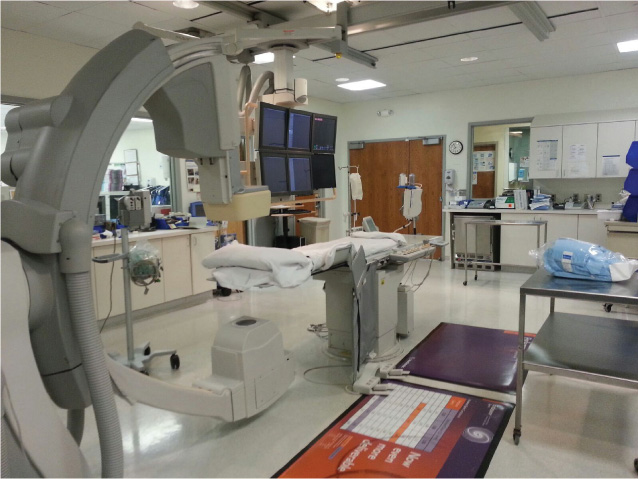CHAPTER 2 “Any sufficiently advanced technology is indistinguishable from magic.” —Arthur C. Clarke Most cardiac catheterization laboratories consist of two separate rooms. The control room is used for monitoring the patient’s vital signs, hemodynamics, and ECG tracings. Here, physicians discuss the planned procedure and write the final report. Next to the control room is the main laboratory (Figure 2.1). The examination table can be ground-mounted or suspended from the ceiling at one end; it is movable and can be panned, raised, or lowered. The table is centered between a C-shaped structure called a gantry, which houses the laboratory’s radiographic equipment. At the bottom of the gantry is the x-ray source, composed of both an x-ray generator and an x-ray tube. At the top of the gantry, or C-arm, there is an “eye-eye,” the flat detector that provides high-resolution digital imagery. Other equipment located throughout the lab may include, but is not limited to, the following important items: an intra-aortic balloon pump and a code or “crash” cart with a defibrillator. In the catheterization laboratory, invasive blood pressure is monitored, and pressure waves created by cardiac contractions are transmitted through a fluid-filled tube connected to a pressure transducer, which converts the actual pressure waveforms into electrical signals displayed on monitors. One other piece of equipment is the power injector, which allows the physician to administer contrast rapidly and in large volumes. The catheterization laboratory team is composed of several key positions. First, the monitoring person who in the control room closely monitors the procedure, continuously documents vital signs, ECG, hemodynamic parameters of the patient, and informs the operator of any abnormalities noticed. This position is staffed by a nurse or by a catheterization laboratory/radiology technician who is knowledgeable in cardiac hemodynamics and ECG readings. The next position is a circulating nurse who monitors O2 saturation, CO2 content, and noninvasive blood pressure. The circulating nurse also assists the patient and administers medications and intravenous fluids throughout the case. The other individual is the scrub person, staffed by a certified cardiovascular technician or a trained cardiovascular nurse. The role of the scrub person is to provide direct procedural assistance to the physician by panning the table, injecting contrast, and administering intra-coronary drugs. Contrast media are used in the cardiac catheterization laboratory for intravascular and intracardiac imaging. They are available in two forms, ionic and non-ionic, categorized by their chemical makeup and differences in osmolality and viscosity. Although high viscosity is a quality of many contrast media at room temperature, viscosity decreases markedly when the medium is warmed to 37°C. The first generation of contrast agents were ionic monomers, high-osmolar, up to 1800 mOsmol/kg; the second-generation agents were nonionic monomers with osmolality up to 850 mOsmol/kg, so called “low-osmolality” agents; and finally, the third-generation are iso-osmolar agents with osmolality less than 300 mOsmol/kg.1 Contrast media contain iodine; because iodine is an effective x-ray absorber, contrast media are x-ray dense. All contrast agents are derived from benzoic acid. It was discovered that binding the iodine atoms to a benzene ring would enable otherwise toxic and lethal amounts of iodine to be introduced into the body and be entirely filtered by the kidneys. Contrast-induced acute kidney injury is the most significant chemotoxic event of contrast media.2
The Cardiac Catheterization Laboratory
Catheterization Laboratory Equipment
Contrast Agents
![]()
Stay updated, free articles. Join our Telegram channel

Full access? Get Clinical Tree



